|
|
|
Sort Order |
|
|
|
Items / Page
|
|
|
|
|
|
|
| Srl | Item |
| 1 |
ID:
140959
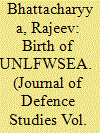

|
|
|
|
|
| Summary/Abstract |
A distinctive feature of insurgency in India’s North-East and neighbouring Myanmar has been the tendency among rebel groups to form alliances. Cooperation is deemed advantageous in a hostile terrain, against a powerful and better organised enemy. Several coalitions were formed in Myanmar by the separatist insurgent outfits with well-defined objectives which, however, failed to produce any significant impact on the campaign for independence of the region. There were centrifugal forces pulling in different directions, often determined by the resources available with the groups, their long- and short-term goals, and the domestic situation in the areas they hailed from. The new alliance called United National Liberation Front of Western South East Asia (UNLWSEA) has emerged in the backdrop of vastly changed situations in Myanmar and India’s North-East. So it is different from the previous endeavours in much the same way as it suffers from the lacunae that hampered complete unity in the past.
|
|
|
|
|
|
|
|
|
|
|
|
|
|
|
|
| 2 |
ID:
133579
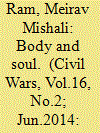

|
|
|
|
|
| Publication |
2014.
|
| Summary/Abstract |
The study presents an integrated model which places the link between the competing state-centric and sub-state explanations of civil strife. As state's capacity and communal fractionalization are typically tested in separate models, the combined framework aims to examine the premise of this article, that communal attributes affect the extent to which state capacity matters in preserving peace and security. The empirical analysis includes 1,385 instances of intrastate conflicts that occurred in 116 countries between 1995 and 2006, drawn from the Major Episodes of Political Violence and the Intra-State War datasets. The results of the study indicate that indeed the weakness of the body is substituted by the strength of the soul: the decline in state authority makes a larger room to sub-state groups, which shape internal dynamics. The second goal of the study is focused on the multifaceted nature of communal traits. Accordingly, the latter part the article offers an actor-oriented analysis, observing the relations between different ethnopolitical groups and violent strife. Based on the qualitative group assessment of the Minorities at Risk project, the study puts to test the argument that not all ethnic groups are alike in their potential to fracture communal solidarity and ignite civil war.
|
|
|
|
|
|
|
|
|
|
|
|
|
|
|
|
| 3 |
ID:
156719
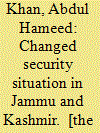

|
|
|
|
|
| Publication |
New Delhi, IDSA, 2017.
|
| Description |
80p.pbk
|
| Series |
IDSA Monograph Series no. 61
|
| Standard Number |
9789382169758
|
|
|
|
|
|
|
|
|
|
|
|
Copies: C:2/I:0,R:0,Q:0
Circulation
| Accession# | Call# | Current Location | Status | Policy | Location |
| 059234 | 320.9546/KHA 059234 | Main | On Shelf | General | |
| 059235 | 320.9546/KHA 059235 | Main | On Shelf | General | |
|
|
|
|
| 4 |
ID:
137404
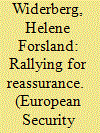

|
|
|
|
|
| Summary/Abstract |
This article examines how allies who shared the same overall goal chose different tactics. It compares how Norway, Poland, and Lithuania pursued a strengthened emphasis on collective defense in the revision of NATO's strategic concept, which was adopted in 2010. In their efforts on influence the outcome of this process, the three allies made use of both bilateral and multilateral channels, but differed in terms of rhetoric, political access, use of media, and mix of national and alliance interests. The article finds that not only size, but also different levels of alliance maturity and diplomatic skills can explain the different tactics. As the study demonstrates, these differences not only create internal dynamics in the form of learning and division of labor, but they can also affect decision-making.
|
|
|
|
|
|
|
|
|
|
|
|
|
|
|
|
| 5 |
ID:
099253
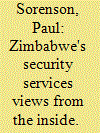

|
|
|
|
|
| Publication |
2010.
|
| Summary/Abstract |
The testimony of ex-servicemen provides a unique insight into Zimbabwe's security architecture. The country's war veterans - many only in their early twenties at independence - are still firmly embedded in the status quo, and remain ideologically committed to Zanu-PF. Though junior officers may be disillusioned, a coup is nevertheless unlikely unless Mugabe loses control of the carefully constructed system of fear, nepotism and loyalty.
|
|
|
|
|
|
|
|
|
|
|
|
|
|
|
|
|
|
|
|
|